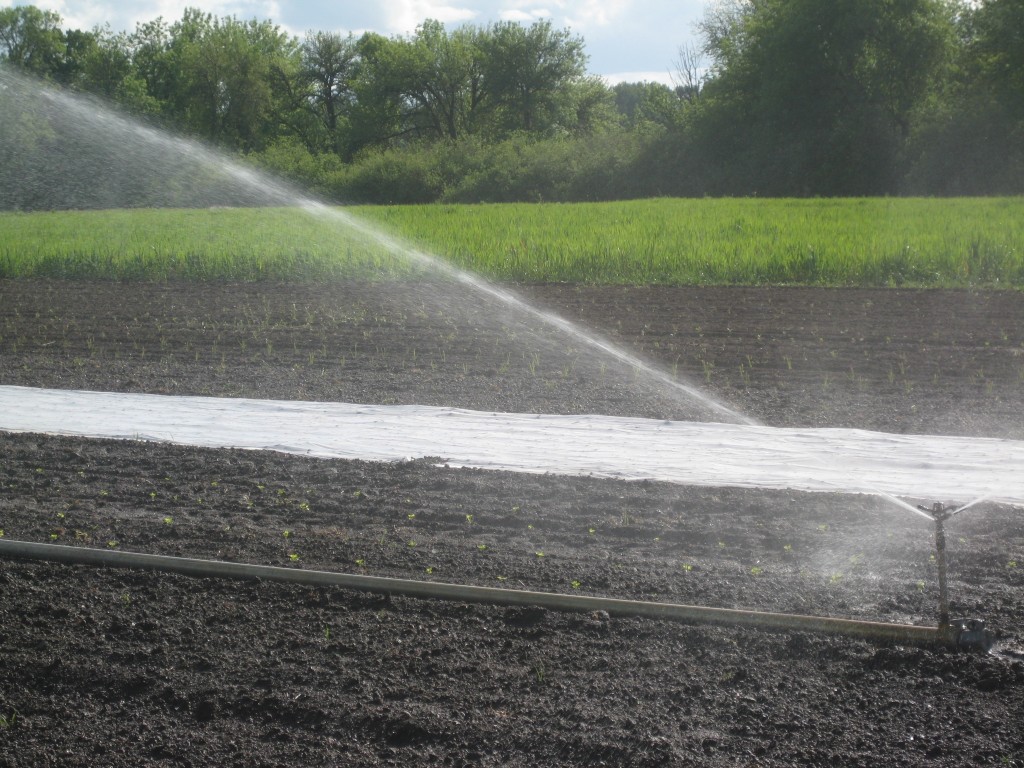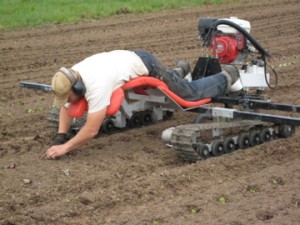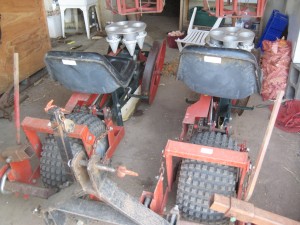
Newly transplanted starts getting watered in our fields this afternoon. These went into the ground QUICKLY.
We bought a new tool for the farm this week. Such acquisitions always bring with them equal amounts of excitement/hope and anxiety/worry. Now that we are in our tenth season, we have a thorough understanding of how technology can be time-(and back-)saving, but also how new tools can bring new complications to existing systems (along with their own mechanical quirks to figure out).
This week’s new tool was a biggie in terms of money outlay and potential for the farm. We bought a two row mechanical transplanter. We resisted buying a mechanical transplanter for a long time (ahem, we are in our tenth season after all!). We were hesitant because they require at least two people to operate (one in the tractor driver seat, one on the transplanter); they generally require specific soil prep conditions; they require specific start conditions; and they can generally impose a more rigid set of planting circumstances because it becomes more onerous to adjust in-row plant spacing, bed spacing, planting depth, etc.
None of this creates insurmountable obstacles, but we knew that technologies such as this remove flexibility. It just becomes harder, even if the technology only creates a psychology barrier to changing things rather than creating a true obstacle. For example, if changing bed spacing requires adjusting the planter, how often will we do it? Or, will we just choose an average mostly-good bed spacing and stick with it for all of our planting? Experiences tells us that the latter option is most likely amidst a busy farm.
Until now, we’ve planted by hand. We walk down the row “laying out” starts at the appropriate spacing, and then another person follows behind planting — quickly scooping a divot in the ground and packing the start in. We do this quickly, giving each start just a few seconds of attention. The movement becomes automatic very quickly. However, need we say that this is hard work? Not so hard in the first five minutes. Or even the first hour. But a whole morning/afternoon/day of planting can be exhausting and lead to aching back and legs. Even the laying out process can be tiring because one needs to slightly lean over to avoid hurting the plant by dropping it from too high.

Casey planting with the Drängen back when we first acquired it in 2008. We bought ours used from another farm, who imported it from Europe. Now they can be purchased domestically.
Many years ago, we acquired a nifty tool/tractor that we used to help ease the back ache from this work. It’s called a “Drängen” work cart, and it’s a self-propelled platform that allows a person to move over the field in a face-down prone position. These types of tools were developed in northern Europe, where high labor costs mean that owner operators and their families still do quite a lot of field work themselves (much like Casey, who does physical work all day). These farmers need body-saving mechanisms to avoid early burn out! I think it’s a really neat design, and we have used our Drängen with off-and-on success over the years. We learned that it does require a typical northern European body to use effectively (i.e. long arms), and that it does require patience to adjust it to one’s body shape (otherwise it creates other body problems). But when used effectively, it definitely helped with the planting process (at least with the planting; the laying out was still done in the old way), and we like that it didn’t impose any particular bed or row spacings onto our system. It felt very flexible.
But the Drängen wasn’t a perfect solution, and we’ve continued to ponder mechanical transplanters, since so many of our farmer friends have employed them with great success (albeit with modifications to their plantings systems to make them work!). When a certain type of transplanter showed up for sale locally on craigslist, we jumped on it. The seller let us borrow it this last week to give it a try. And, yes, there was a lot of tinkering to be done to get the adjustments right for our starts and spacing and such. Oh, yes. Plenty.

The new transplanter, a two-row Mechanical 4000, parked in our pole building for now. Note the SEATS. Cushy. The starts get dropped in the little rotating cones and then tamped in as the transplanting rolls along.
But, then. Then there was planting. Lots and lots of planting. The owner actually came out to help one afternoon, and he, Casey, Jasper, and our friend Duncan planted in three hours what would have probably taken two days to plant using our old methods. And, I should add, these were three hours of sitting down in comfortable positions. This trial demonstration was very compelling, and need I add that we wrote our new friend a check the very next day?
Again, we know that this new tool will likely bring us headaches. There will be more mechanical blips and weird things where we find that our starts are falling through the chute right and breaking on the ground. Such things will happen. But sometimes those minor headaches are totally worth the payoff. Sometimes technologies really can bring new levels of efficiency to the farm! We are excited to see that be true with this new tool.
The irony, of course, is that with the increased speed of planting time, our transplanter will likely sit unused for big chunks of the year! I think this is how many of our friends’ farms have grown and grown and grown in acreage over the years — they adopt new efficient technologies and find themselves with the time to plant/weed/do more. I’m hoping that we can instead just feel grateful for the efficiencies and allow them to bring ever more sanity to this farm — to grow those luxurious-feeling buffers of time around our work. For sure, we will be grateful to any tool that gives us more comfortable bodies as we do our work on the farm. We are very aware that our bodies (and those of our employees) need to be part of the farm’s long-term sustainability vision!
And, are you wondering what we planted? Cabbage! Cauliflower! Chard! Lettuce! Leeks! Onions! (Leeks and onions are notoriously the hardest, most laborious, frustrating transplants of the year — getting those in with this machine was a great test of exactly why we’d been wanting it. What a relief to have those big plantings already in the ground, without the usual accompanying back ache!)
This Friday, we do more planting — potatoes on May Day! Again, if you are planning to join us for the planting/potluck (or one or the other), please RSVP at pick-up this week (or email me if that works better). We need to know how many people to expect! You can find directions and more information in last week’s newsletter here. The weather is supposed to be perfect! (And, again, if you can’t join us this time, no problem! We hope to have you out another time this year!)
Enjoy this week’s vegetables!
Your farmers, Katie & Casey Kulla
~ ~ ~
Meet this week’s vegetables:
- Salad mix — We have been eating lots of salads in our house this spring. We add meat on top and call it an easy meal for these busy days. I always make a salad dressing fresh for each salad. It’s super simple using an immersion blender, and we love the results. I mix up my preference, but lately I’ve been making a really satisfying variation on mayonnaise. I use a wide-mouthed pint mason jar and add one raw egg and a bit of vinegar (maybe equal proportions to the egg itself — I mix up what kind of vinegar, switching between Red Wine, Balsamic, and Apple Cider). I add some salt and pepper and a clove of garlic if I’m up for peeling it. Then I put it my immersion blender and start blending while drizzling in olive oil. When the dressing reaches about the one-third mark, it starts getting thick and emulsifies. The more oil, the thicker it gets. I usually stop when the jar is about half full, which in my experience results in a nice creamy dressing (I like using less oil so that you can better taste the vinegars, but more oil would make it stiffer and more like mayo). We dress our salad liberally just before serving. I always dress it in a large bowl, using my hands so that all the leaves get coated evenly. Like I said, we eat meat on top to make it a meal, but you can add all kinds of filling toppings to achieve this effect (perhaps varying the vinegars/oils to nicely complement flavors): cubes of cheese, nuts, smoked fish, dried fruit, chopped veggies, sliced hard-boiled eggs, etc.
- Stinging nettles
- Red Russian kale
- Mustard/kale bunches — These are mixed bunches of mustard greens and “dinosaur” kale, picked from our greenhouses. Dino kale goes by many names: lacinato, black kale, black palm, tuscano. It’s probably the most favored kale of the restaurant world, but it is harder to grow than other varieties (of course!). In some times of the year, the ribbing gets tougher, but this spring greenhouse kale is tender all the way through. I chop it finely (chiffonade), ribbing and all, to cook for our meals. The mustards can be cooked with it. A delicious blend of flavorful cooking greens!
- Chard
- Parsley
- Celery leaf
- Beets
- Potatoes
- Leeks
- Green garlic
- Walnuts
And this week’s extra goodies from the farm: Remember to bring containers when appropriate! Especially for eggs!
- Corn flour — $5 lb
- Oat flour — $5 lb
- Walnuts — $5 lb
- Sauerkraut — $5 pint / $3 half pint ($1 for our jars). We still have some cabbage sauerkraut. We decided to take a week off of fermented veggies for now as we figure out the next direction for our crock (what comes next?).
- Eggs — $4 dozen
- Pork cuts — We’ve got pork! Lots of pork! Have you ever tried braising pork belly? This is the same cut that gets used to make bacon. Bacon is delicious, and it’s not just because of the curing. Try it fresh! It’s a revelation!
- Pork fat & skin — $3 lb
- Lamb organs — We’ve got organs left, and we are taking more lambs to the butcher next week. Since they will be aged before cutting, lamb will be back in full force in two weeks.
- Ground beef — $7 for 1 lb package ~ Almost out! Just like the lamb, we’ll have more in two weeks.
- Bacon, ham, sausage — Coming soon! We delivered four hogs to the butcher this week, with instructions for all of the meat to be turned into various yummy things: bacon, ham, sausage — all of it using the natural “celery seed” method for “curing” (technically, they call the results “uncured,” but don’t let this lead you astray, because the bacon is most definitely bacon, etc.). These should be ready in a few more weeks, and we are so excited to share them with you!



Super interesting this week, Katie. I always wondered how all this work gets done since I can barely weed my small raised beds. Draengen!
Pingback: The community season | Oakhill Organics